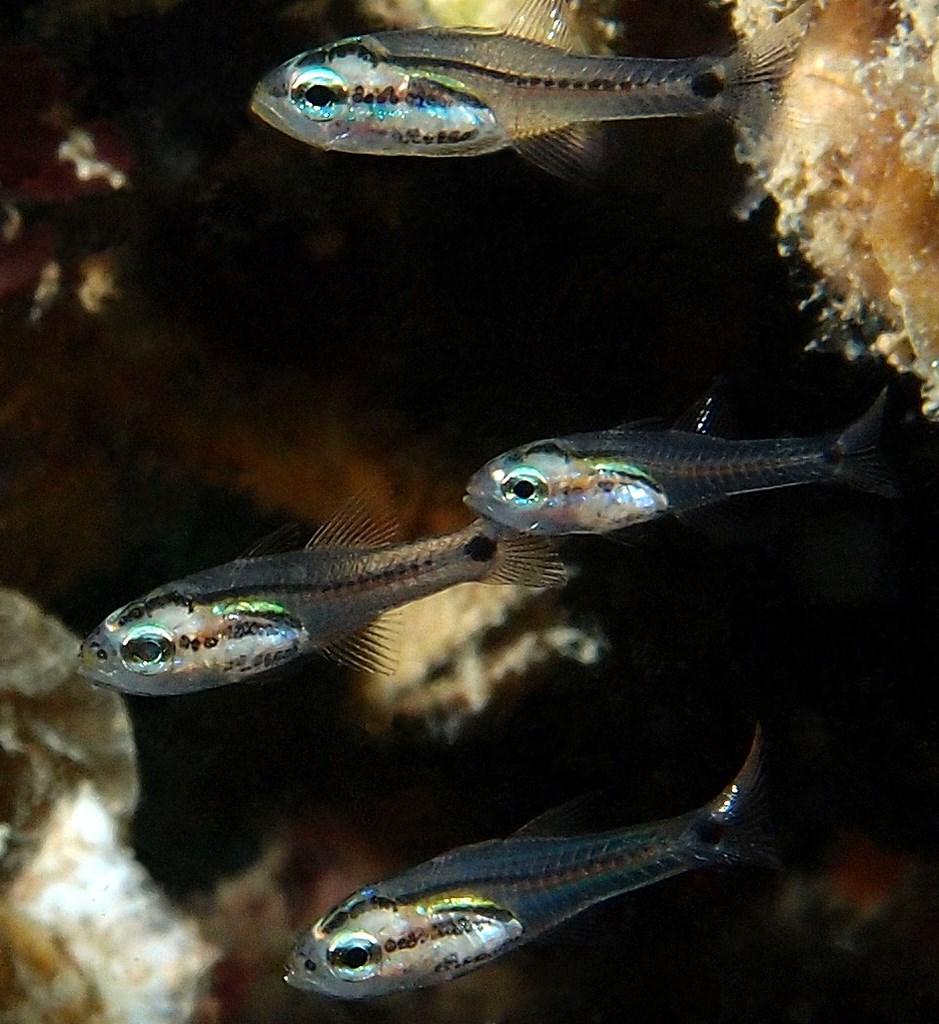OSTORHINCHUS DOEDERLEINI - (JORDAN & SNYDER, 1901)
Actinopterygii (Gigaclass) > Actinopteri (Class) > Teleostei (Subclass) > Gobiiformes (Order) > Apogonoidei (Suborder) > Apogonidae (Family) > Apogoninae (Subfamily) > Ostorhinchus (Genus)
Poisson cardinal de Döderlein, Apogon de Döderlein, Doederlein's cardinalfish, Four-line Cardinalfish, Fourline cardinalfish, ôsuji-ishimochi, オオスジイシモチ, 稻氏鹦竺鲷, 稻氏天竺鯛,
Synonymes
Apogon doderleini (Jordan & Snyder, 1901)
Apogon doederleini (Jordan & Snyder, 1901)
Apogon doderleini (Jordan & Snyder, 1901)
Apogon doederleini (Jordan & Snyder, 1901)
-------------------------
Description
Dorsal spines (total): 8; Dorsal soft rays (total): 9; Anal spines: 2; Anal soft rays: 8; Pectoral fin rays: 15; Pelvic fin rays: I, 5; Pored lateral line scales: 24; Predorsal scales: 3; Circumpeduncular scales: 12; Caudal fin base spot subequal in size to pupil diameter. Max. length: 9.0 cm TL. Depth range: 0 - 30 m.
Dorsal spines (total): 8; Dorsal soft rays (total): 9; Anal spines: 2; Anal soft rays: 8; Pectoral fin rays: 15; Pelvic fin rays: I, 5; Pored lateral line scales: 24; Predorsal scales: 3; Circumpeduncular scales: 12; Caudal fin base spot subequal in size to pupil diameter. Max. length: 9.0 cm TL. Depth range: 0 - 30 m.
Color
Body pinkish brown, with four dark brown stripes on lateral surface of body; Third stripe posteriorly not reaching to a black spot on caudal fin base.
Etymology
Ostorhinchus: from Greek, osteon = bone + from Greek, rhynchos = beak. In reference to the bony jaws, very much advanced and jagged, which take the place of the teeth.
doederleini: in honnor of Ludwig Heinrich Philipp Döderlein (1855–1936) who was a German zoologist. He specialized in echinoderms, particularly sea stars, sea urchins, and crinoids.
Original description: Apogon doederleini Jordan & Snyder, 1901 - Type locality: Nagasaki, Japan.
Ostorhinchus: from Greek, osteon = bone + from Greek, rhynchos = beak. In reference to the bony jaws, very much advanced and jagged, which take the place of the teeth.
doederleini: in honnor of Ludwig Heinrich Philipp Döderlein (1855–1936) who was a German zoologist. He specialized in echinoderms, particularly sea stars, sea urchins, and crinoids.
Original description: Apogon doederleini Jordan & Snyder, 1901 - Type locality: Nagasaki, Japan.
Distribution
Western Pacific: subtropical, from southern Japan to Taiwan, then from subtropical Australia to New Caledonia and the Kermadec Islands. The species has an antitropical distribution in the west Pacific.
Western Pacific: subtropical, from southern Japan to Taiwan, then from subtropical Australia to New Caledonia and the Kermadec Islands. The species has an antitropical distribution in the west Pacific.
Biology
Commonly occurs in rocky areas near shore and abundant on ledges. Solitary but pair off during breeding. Mouth brooding is done by the male. Nocturnal species.
Gerlach et al. 2016 found several genetically distinct but morphologically similar clades of Ostorinchus doederleini on the Great Barrier Reef.
Commonly occurs in rocky areas near shore and abundant on ledges. Solitary but pair off during breeding. Mouth brooding is done by the male. Nocturnal species.
Similar species
Ostorhinchus endekataenia (Bleeker, 1852) - Reported from Western Pacific: Singapore, Malaysia and Indonesia north to southern Sea of Japan, south to northern Australia. Whitish body color; 6 red-brown stripes, incomplete stripes or rows of spots in between; Base of caudal fin with large black spot. Max. length: 14.0 cm TL.
Ostorhinchus endekataenia (Bleeker, 1852) - Reported from Western Pacific: Singapore, Malaysia and Indonesia north to southern Sea of Japan, south to northern Australia. Whitish body color; 6 red-brown stripes, incomplete stripes or rows of spots in between; Base of caudal fin with large black spot. Max. length: 14.0 cm TL.
Ostorhinchus limenus (Randall & Hoese, 1988) - Reported from Southwestern Pacific: southern Queensland south to northern New South Wales (Australia). Distinguished from other species by the wide gap between the second and third stripe, the circular dark spot on the caudal peduncle, and the short stripe posterior to the upper portion of the eye. Found in rocky estuaries to offshore reefs, usually in small aggregations. Max. length: 14.0 cm TL.
Ostorhinchus neotes (Allen, Kuiter & Randall, 1994) - Reported from Western Pacific: Indonesia east to Palau and New Ireland (Papua New Guinea), north to Philippines, south to Solomon Islands, Great Barrier Reef, Queensland (Australia). A small semi-transparent cardinalfish with a black internal stripe from behind the eye to the caudal peduncle followed by a large black spot at the base of tail, black internal pigment on the abdomen, a white stripe from below the eye across the abdomen, and black pigment along the bases of the dorsal and anal fins. Max. length: 3.0 cm TL.
Gerlach et al. 2016 found several genetically distinct but morphologically similar clades of Ostorinchus doederleini on the Great Barrier Reef.
Last update: 16, February 2023
